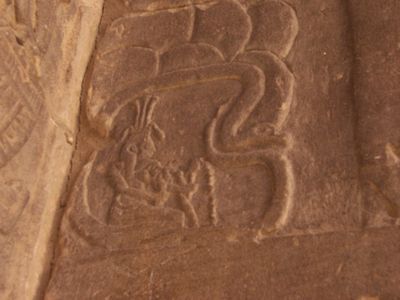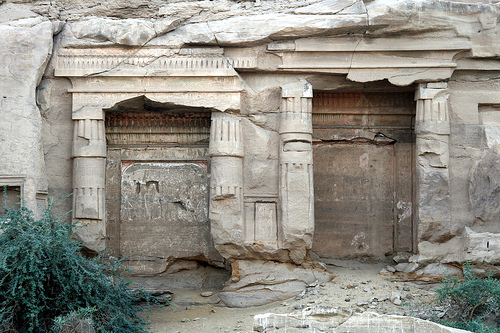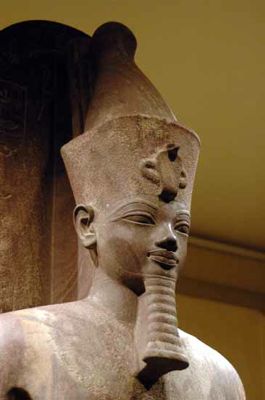Both the Bradley reading and James' presentation on Maya caves has had me reflecting more on caves in ancient Egypt (or the seeming lack thereof). I don't claim to be a geologist or totally familiar with the land formations in Egypt, but surely, somewhere, one would think there would be natural caves. Caves as sacred sites have not come across any of the literature I have ever read, however, and they are not topics I have heard in discussions. The Egyptians certainly knew caves could occur in nature. The mouth of the Nile was believed to be a cave located at the First Cataract, from which it would flood every year during the Inundation.

Hapi, the divine personification of the Nile, crouched in his cave and surrounded by a serpent (possibly representing the Ouroboros).
In a way, however, artificial caves can be understood to be prevalent throughout the archaeological remains of pharaonic Egypt, in the form of rock-cut tombs and temples. Egypt consists of vast expanses of desert that cannot be utilized for agriculture or habitation. Therefore, building tombs from the living rock cannot be explained away as a merely a good use of the available space, because they could have been built on the desert. Instead, beliefs associated with the location of the Duat, the realm of the dead, made it appropriate for the deceased to be buried into the limestone cliffs.
A rock-cut temple (speos), however, was less common and not natively Egyptian. They were borrowed from Nubia, and therefore are most commonly found in southern (Upper) Egypt. Ramses II was especially prolific in constructing these types of temples and smaller chapels, the most famous being his temples at Abu Simbel. Interestingly in these types of temples, rock-cut statues of the gods and king are carved at the back of the temples, similar to the statues of tomb owners in the shrines of rock-cut tombs. Although these statues differ from the traditional, hidden cult images of the god placed in the Djeser-djeseru ("Holy of holies") of Egyptian temples, they clearly represent the focal point of the structure. If the restricted access of other Egyptian temples existed at these speoi, then the seemingly high visibility of these statues would not have been an issue.

Façades of chapels at the quarry of Gebel Silsila, carved into the rock.
The Egyptians ascribed value to different stones, so the notion of cutting into the living rock must have carried some religious significance. It would be difficult to say how this would differ from the commissioning of statues out of stones from specific stone quarries, which, as Boivin noted in her article, were not always the most convenient. The Dean article on the Inka practice of integrated outcrops really interested me because of this: does the evidence support an argument that incorporating a structure into the solid cliffs perhaps link the temple into the cosmos in a more direct way? I do not know what work has been done looking at the rock-cut temples in particular, but such an idea is interesting to think about.
 Quartzite, larger-than-life statue of Amenhotep III. The quartzite of this and his colossi placed before his mortuary temple (known as the 'Colossi of Memnon') were long assumed to have come from quarries near Aswan in the south of Egypt, until later studies suggested that stone actually originated from a quarry near Cairo, much much farther away.
Quartzite, larger-than-life statue of Amenhotep III. The quartzite of this and his colossi placed before his mortuary temple (known as the 'Colossi of Memnon') were long assumed to have come from quarries near Aswan in the south of Egypt, until later studies suggested that stone actually originated from a quarry near Cairo, much much farther away.
